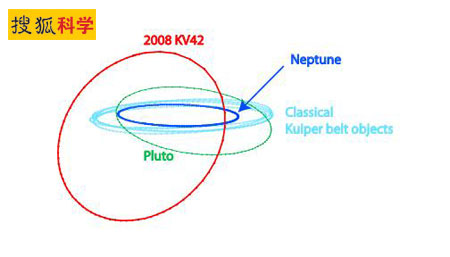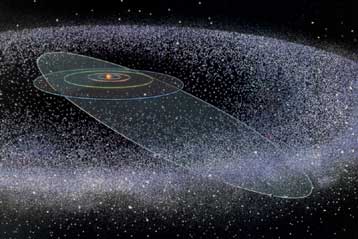|
|
2008年09月05日10:28
【搜狐科學消息】 據英國《新科學家》雜誌報道,一支國際科學家小組在寒冷的“柯伊伯帶”中發現了一顆與眾不同的天體,它是倒著圍繞太陽運轉的,且相對大多數其它太陽系天體來說,其軌道面還是傾斜的。這或許可以解釋以哈雷彗星為代表的神秘彗星家族的起源。柯伊伯帶位於太陽系的盡頭,由冰冷天體形成的環,其名稱源於荷蘭裔美籍天文學家柯伊伯(Kuiper)。
此新天體被命名為“2008 KV42”,其軌道與地球運行的軌道面或黃道形成103.5°夾角。 這意味著當它圍繞太陽運轉時,它的運行方向確實和地球的運行方向相反。由英屬哥倫比亞大學的布雷特?戈爾德曼領導的科學家小組於今年5月首次發現此獨立特行的天體。其觀察結果表明它的直徑大約為50公里,其運行路線距離太陽20-70天文單位,1天文單位是地球到太陽的距離。相比之下,“2008 KV42”和天王星都離太陽差不多的距離,但相對海王星與太陽的距離就要遠上2倍以上了。
研究人員發現“2008 KV42”的運行軌道似乎數億年一直都很穩定,但他們表示它可能出生於其它地方。美國馬薩諸塞州劍橋小行星中心的布賴恩·馬斯頓說:“這的確令人好奇地想問它到底來自哪裡。”
戈爾德曼表示它可能出生于和哈雷彗星同一個地方。這些彗星也倒著圍繞太陽運轉或具有高度傾斜的運行軌道面,且可以持續運行20-200年不等,但不同的是,它們距離太陽都更近一些。
目前天文學家還不清楚這類彗星是從哪裡形成的。電腦模型表明它們全都不是在其它類型彗星的2個出生地中形成的,這二個出生地是柯伊伯帶和更加遙遠的奧特雲(Oort cloud)。而奧特雲是太陽系週邊的一圈巨大冰天體形成的球形雲,這裡環繞著無數彗星。奧特雲距離太陽大約2萬-20萬天文單位,它是1950年由荷蘭天文學家簡?奧特首次發現的。
戈爾德曼小組計算出“2008 KV42”雖然出現于現于柯帶的偏遠處,但相對奧特雲卻更近一些。一些科學家將距離太陽2-5萬天文單位的這一奧特雲區域叫“內奧特雲”。
天文學家推測引力作用可能將“2008 KV42”從內奧特雲中“踢”了出來,導致出現在現有的軌道上。戈爾德曼表示它可能有一天會被踢出其軌道,進入一條離太陽更近的軌道上運行,從而使它成為一顆“過渡天體”,最終將成像哈雷彗星一樣的天體。這種天體的軌道路線可以讓我們看到太陽系的早期歷史。
戈爾德曼小組一直在搜尋具有高度傾斜軌道的天體,他們利用很多進階望遠鏡已經發現20多顆其它柯伊伯帶的天體也具有非常傾斜的運行軌道面,但沒有發現其中一顆天體具有逆行軌道。戈爾德曼說:“某些彗星並不是行星形成後自然產生的,特別是這些軌道高度傾斜的彗星,此發現可能最終表明它們是如何從奧特雲中的小行星轉變為像哈雷彗星一樣的天體。”

新天体轨道运行方向和地球运行方向相反
(法新社)9月5日 星期五 13:35
(法新社蒙特婁四日電) 加拿大「國立研究諮詢中心」今天報告說,加拿大、法國和美國天文學家已發現一顆運行軌道奇怪的怪異小行星,這可能有助於解釋慧星的起源。
國立研究諮詢中心發表聲明說:「被命名為2008 KV42的這顆小行星是以倒退的方式繞著太陽運行,而且是以與一般行星運行軌道幾乎垂直的一百零四度傾斜運行,這種奇特的軌道顯示,2008 KV42可能是從歐特雲被拉入我們的太陽系中。」
歐特雲包圍太陽系,但距離太陽系卻非常遙遠,據信它包含了數十億顆慧星。這項發現可能讓我們更加了解慧星如何從歐特雲轉變為諸如哈雷慧星等物體。
研究諮詢中心的卡夫博士說:「雖然我們一直在泛冥王星星球中,刻意尋找高度傾斜的星球,但我們沒有預料到會找到一顆逆行的星球。」
這項發現應歸功於加拿大─法國─夏威夷在夏威夷共同興建的太空望遠鏡。這些發現由設在美國亞歷桑那州和智利的太空望遠鏡繼續追蹤。
00:35 05 September 2008
NewScientist.com news service
Jeff Hecht
An object in the icy Kuiper belt has been found orbiting the Sun backwards, compared to most other objects in the solar system. It may help explain the origin of an enigmatic family of comets typified by Comet Halley.
The new object, called 2008 KV42, lies in the Kuiper belt, a ring of icy bodies beyond Neptune. Its orbit is inclined 103.5° to the plane of the Earth's orbit, or ecliptic. That means that as it orbits the Sun, it actually travels in the opposite direction as the planets.
Researchers led by Brett Gladman of the University of British Columbia first spotted the maverick object in May. Observations suggest it is about 50 kilometres across and travels on a path that takes it from the distance of Uranus to more than twice that of Neptune (or between 20 and 70 astronomical units from the Sun, with 1 AU being the Earth-Sun distance).
Its orbit appears to have been stable for hundreds of millions of years, but astronomers say it may have been born elsewhere. "It's certainly intriguing to ask where it comes from," says Brian Marsden of the Minor Planet Center in Cambridge, Massachusetts.
Gladman says it was probably born in the same place as Halley-type comets. These comets also travel on retrograde or highly tilted orbits – lasting between 20 and 200 years, but they come closer to the Sun.
Missing link
It has been unclear where such comets come from. Computer models suggest they do not arise in either of the two birthplaces of other types of comets – the Kuiper belt or the much more distant Oort cloud, a shell of of icy bodies lying between 20,000 and 200,000 AU from the Sun.
Gladman's team calculates that 2008 KV42 arises beyond the Kuiper belt but closer than the Oort cloud, in a region thought to lie between 2000 to 5000 AU from the Sun. Some astronomers call the zone the inner Oort cloud.
A gravitational disturbance likely kicked 2008 KV42 out of the inner Oort cloud and to its present orbit. And Gladman says it might one day be pushed out of that orbit and into one that brings it closer to the Sun, making it a possible "transition object" on its way to becoming a Halley-type comet.
Gladman's team has found more than 20 other Kuiper belt objects with steeply inclined orbits while surveying the sky well away from the ecliptic – but no others with a retrograde orbit.
The orbit of the object 2008 KV42 is so tilted with respect to the planets that it travels backwards around the Sun. It has been nicknamed "Drac" for "Dracula", since vampires supposedly have the power to walk on walls (Illustration: CFEPS)

http://hk.youtube.com/watch?v=7u_xIc5myyk
德文:
http://hirek.csillagaszat.hu/kuiper-objektumok/20080728-ilyen-egitest-marpedig-nincs.html
[ 本帖最后由 p9phmoud10号 于 2008-9-8 22:24 编辑 ] |
|
 |小黑屋|手机版|Archiver|Nw壬天堂世界
( 京ICP备05022083号-1 京公网安备11010202001397号 )
|小黑屋|手机版|Archiver|Nw壬天堂世界
( 京ICP备05022083号-1 京公网安备11010202001397号 )